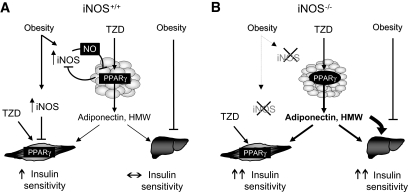FIG. 7.
Proposed model by which iNOS induction in obesity modulates thiazolidinedione (TZD)/PPAR-γ agonism in insulin-target tissues. A: In wild-type iNOS+/+ mice, obesity leads to iNOS induction in fat and muscle, which contributes to promote insulin resistance in muscle and impairs PPAR-γ action in adipose tissue. Obesity also impairs hepatic insulin action even if iNOS is not induced, as shown in liver of high-fat–fed obese mice (18). PPAR-γ agonists, such as thiazolidinediones, reduce iNOS induction in obese iNOS+/+ mice, leading to improvement in insulin action in muscle but not in liver. B: iNOS disruption (iNOS−/−) increases muscle insulin action but also sensitizes obese mice to the effect of PPAR-γ ligands on adipose tissue, leading to an increased number of smaller adipocytes and enhanced secretion of adiponectin, particularly in its high–molecular weight complex form. Elevated high–molecular weight adiponectin mainly targets the liver through AMPK activation, resulting in increased hepatic insulin action and improved glucose tolerance.

